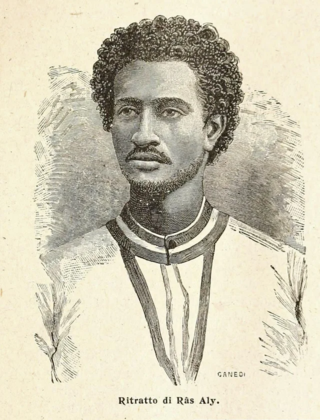Related Research Articles
Yohannes III was Emperor of Ethiopia intermittently between 1840 and 1851, and a member of Solomonic dynasty. He was the son of Tekle Giyorgis. He was largely a figurehead, with real power in the hands of the Enderase or Regent, Ras Ali II a princeling of the Yejju Dynasty. Ras Ali's mother was the Empress Menen Liben Amede.
Iyasu or Joshua was a proclaimed Emperor of Ethiopia from 1787 to 1788 in Tigray and Gojjam by enemies of Ras Ali I of Yejju. He was defeated in battle against Ras Ali.
Gebre Krestos was Emperor of Ethiopia from 24 March 1832 to his death on 8 June 1832. He was the son of Gebre Mesay, allegedly a descendant of a younger son of Emperor Fasilides.
Sahle Dengel was Emperor of Ethiopia intermittently between 1832 and 11 February 1855, towards the end of the Zemene Mesafint. He was largely a figurehead, with real power in the hands of Ras Ali II of Yejju.
Marye of Yejju was a Ras of Begemder and Enderase (regent) of the Emperor of Ethiopia. He was the brother of his predecessor Ras Yimam.
Dori of Yejju was a Ras of Begemder and Inderase (regent) of the Emperor of Ethiopia. He was the brother of his predecessor Marye of Yejju.
Gugsa of Yejju was a Ras of Begemder, and Inderase (regent) of the Emperor of Ethiopia. According to Nathaniel Pearce, he took the Christian name of Wolde Mikael. He was the son of Mersu Barentu and Kefey, the sister of Ras Aligaz. Both Bahru Zewde and Paul B. Henze consider his reign as Ras and Enderase as the peak of the Yejju Dynasty during the Zemene Mesafint.
Aligaz of Yejju was Ras of Begemder, and Inderase (regent) of the Emperor of Ethiopia. He was the son of Abba Seru Gwangul and brother of Ali I of Yejju; he became both Ras and Inderase following Ali's death. Aligaz had four sons: Dejazmach Birru, Dejazmach Gobeze, Dejazmach Faris, and Dejazmach Gojjee.
Ali I of Yejju was Ras of Begemder, and following the death of Ras Mikael Sehul, Regent of the Emperor of Ethiopia. He was the son of Abba Seru Gwangul, chieftain of the Yejju, and Woizero Gelebu Faris, daughter of Ras Faris of Lasta.

Ali II of Yejju was Ras of Begemder and the de facto ruler of the Ethiopian Empire. He was a member of a powerful Oromo dynasty known as the Yejju, which ruled much of the Ethiopian Empire during the Zemene Mesafint.

Mikael Sehul was a nobleman who ruled Ethiopia for a period of 25 years as regent of a series of weak emperors. He was also a Ras or governor of Tigray 1748–71 and again from 1772 until his death. He was a major political figure during the reign of Emperor Iyasu II and his successors until almost the time of his death.

Sabagadis Woldu was a governor of Tigray Province of the Ethiopian Empire from 1822 to 1831. Sabagadis gained some notoriety in the first decade of the 19th century for rebelling a number of times against his overlord, Ras Wolde Selassie. But just before the death of Wolde Selassie it seems that he made up with his master and became one of his loyal lieutenants. Following Wolde Selassie's death in 1816, he defied the authority of Wolde Selassie's son, and became the most powerful warlord in Tigray. Making Adigrat his capital, he ruled Tigray and a small strip of the coastal plains of Eritrea by 1818. His rule also extended to the Eritrean highlands.
Wossen Seged was a Merid Azmach of Shewa, an Amhara noble of Ethiopia. He was the elder son of Asfa Wossen, by a woman of the Solomonic dynasty. He was the first ruler of Shewa to claim a higher title than Merid Azmach, calling himself Ras.
The Battle of Amba Jebelli was fought in Ethiopia in 1854 between the forces of Kassa Hailu, and the forces of Birru Goshu of Gojjam. Kassa was victorious, Birru Goshu was captured and spent the next 14 years in chains.

The Zemene Mesafint was a period in Ethiopian history between the mid-18th and mid-19th centuries when the country was ruled by a class of Oromo elite noblemen who replaced the Tigrayan and Amhara nobility in their courts, making the emperor merely a figurehead. For the most part, the regional lords were tightly related by marriage and constituted a stable ruling elite that prevailed until the mid 20th century. In short, during the Zemene Mesafint, the Emperors from the Solomonic dynasty were reduced to little more than figureheads confined to the capital city of Gondar.
Dejazmach Birru Aligaz was a nobleman of 19th century Ethiopia during the Zemene Mesafint. As Dejazmach, he held the governorships of different districts such as Lasta and Dembiya and was made governor of Dawunt, Wollo in 1842 by Ras Ali II of Yejju. He was the son of Ras Aligaz Abba Seru Gwangul, and had a son called Dejazmach Zegeye.
Dejazmach Zegeye Birru was the son of Dejazmach Birru Aligaz. He was the ruler of Yejju until the emergence of Ras Welle Betul. Dejazmach Zegeye had four sons and a daughter: Wagshum Gwangul, Dejazmach Ali, Dejazmach Hailu, Dejazmach Aligaz, and Woizero Hirut.

Wube Haile Maryam of Semien, (1799-1867), also called by his title Dejazmach Wube, Webé; his name is also given in European sources as ‘‘Ubie’’. Wube was one of the major figures of 19th century Ethiopia, during the closing decades of the Zemene Mesafint a period of regional lords vying for power, prestige and territory amid a weakened authority of the emperors.
Menen Liben Amede was Empress consort of Ethiopia by marriage to Emperor Yohannes III in 1840–1841, 1845 and 1850–1851.
Betul Haile Maryam was a member of the Semien nobility through his paternal line.
References
- ↑ Charles T. Beke, "Abyssinia. Being a Continuation of Routes in That Country", Journal of the Royal Geographical Society , 14 (1844), p. 6